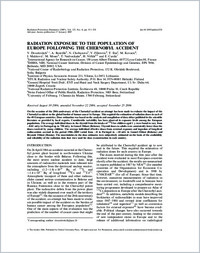Radiation exposure to the population of Europe following the Chernobyl accident
Université de Fribourg
- Drozdovitch, V. International Agency for Research on Cancer, 150 cours Albert-Thomas, Lyon, France
- Bouville, A. DHHS, NIH, National Cancer Institute, Division of Cancer Epidemiology and Genetics, Bethesda, USA
- Chobanova, N. National Center of Radiobiology and Radiation Protection, Sofia, Bulgaria
- Filistovic, V. Institute of Physics, Vilnius, Lithuania
- Ilus, T. STUK Radiation and Nuclear Safety Authority, Helsinki, Finland
- Kovacic, M. General Hospital ‘Sveti Duh’, ENT and Head and Neck Surgery Department, Zagreb, Croatia
- Malátová, I. National Radiation Protection Institute, Srobárova Praha, Czech Republic
- Moser, M. Swiss Federal Office of Public Health, Radiation Protection, Bern, Switzerland
- Nedveckaite, T. Institute of Physics, Vilnius, Lithuania
- Völkle, Hansruedi Swiss Federal Office of Public Health, Radiation Protection, Bern, Switzerland - University of Fribourg, Switzerland
- Cardis, E. International Agency for Research on Cancer, 150 cours Albert-Thomas, Lyon, France
-
2007
Published in:
- Radiation Protection Dosimetry. - 2007, vol. 123, no. 4, p. 515-528
English
On the occasion of the 20th anniversary of the Chernobyl accident an attempt has been made to evaluate the impact of the Chernobyl accident on the global burden of human cancer in Europe. This required the estimation of radiation doses in each of the 40 European countries. Dose estimation was based on the analysis and compilation of data either published in the scientific literature or provided by local experts. Considerable variability has been observed in exposure levels among the European populations. The average individual doses to the thyroid from the intake of ¹³¹I for children aged 1 y were found to vary from ∼0.01 mGy in Portugal up to 750 mGy in Gomel Oblast (Belarus). Thyroid doses to adults were consistently lower than the doses received by young children. The average individual effective doses from external exposure and ingestion of long-lived radiocaesium accrued in the period 1986–2005 varied from ∼0 in Portugal to ∼10 mSv in Gomel Oblast (Belarus) and Bryansk Oblast (Russia). The uncertainties in the dose estimates were subjectively estimated on the basis of the availability and reliability of the radiation data that were used for dose reconstruction in each country.
- Faculty
- Faculté des sciences et de médecine
- Department
- Département de Physique
- Language
-
- English
- Classification
- Physics
- License
- License undefined
- Identifiers
-
- RERO DOC 8501
- DOI 10.1093/rpd/ncl528
- Persistent URL
- https://folia.unifr.ch/global/documents/300495
Statistics
Document views: 55
File downloads:
- ncl528.pdf: 60
